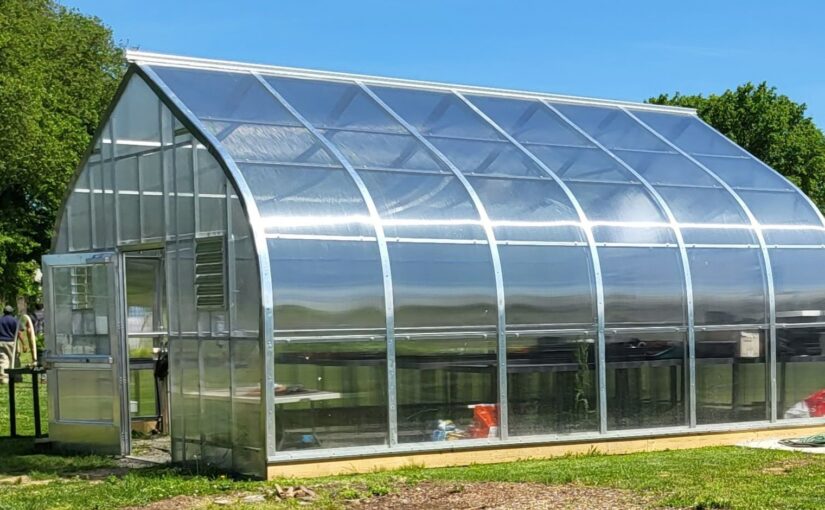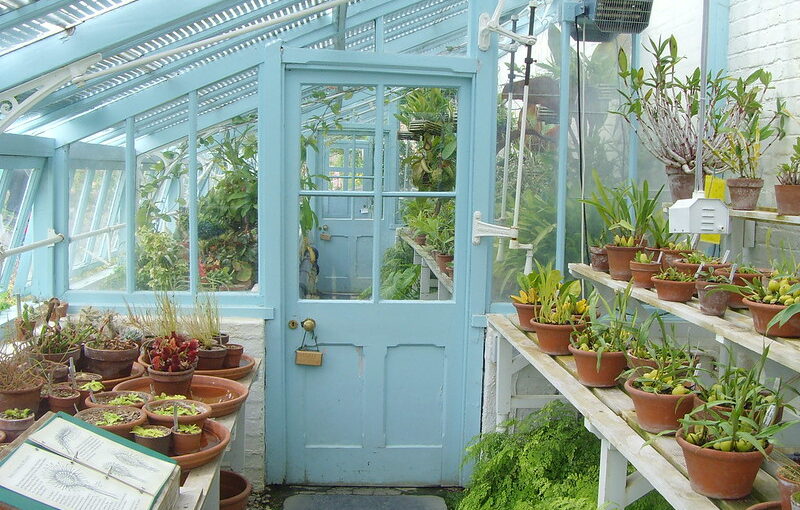Continue reading It’s all Greek to me…
Are we in winter or spring? The answer is YES!
If you’ve been following the national weather this week, you might be wondering if the groundhog has developed a split personality this year. Is winter over or are we in for six more weeks of cold? While the eastern half of the United States is feeling the effects of record-setting high temperatures and one of the earliest springs on record, the western U. S. is observing cold and snowy conditions all the way down into Southern California. I’ve heard reports of snow reaching all the way down to Tucson in southern Arizona.

What is an atmospheric wave?
Some of you may be wondering how we can have some tremendous differences between the eastern and western U. S. at the same time. The reason we see such differences is linked to the wavy pattern of the upper atmosphere, which helps direct warm or cold air into different regions. Today I will discuss atmospheric waves and how they affect the surface weather.
Since air is a fluid, it should not be surprising that it has waves in it. In fact, there are many different types of waves that can occur in the atmosphere, ranging from small-scale pressure waves downwind of mountain ranges to the largest planetary-scale oscillations in pressure. Sometimes you can see some of those smaller-scale waves in clouds occurring above you.

Where do atmospheric waves come from?
What ultimately drives the atmospheric circulation is the temperature difference between the equator which is warm due to direct sunlight and the poles which are cold because whatever little sun they get, especially in winter, is of low angle and there is not much solar energy reaching the surface to heat things up. This temperature difference causes a difference in atmospheric pressure that makes winds blow to try and equalize those differences.
Variations in land versus sea, the rotation of the planet, and differential heating from other causes like drought all contribute to the atmospheric developing waves that look like large swings in the pressure patterns at mid-levels in the atmosphere. Areas where the pressure is low are called troughs and areas where it is high are called ridges, like the patterns we see in topographic maps. Surface fronts are located near the boundary between troughs and ridges where the contrast in temperature and humidity is often the greatest.

How is the current wave pattern driving these big temperature swings?
This week there is a tremendous ridge of high pressure located in the eastern US while a very deep trough is located over the western part of the country. Warm air blowing up from the south under the ridge has brought record-setting high temperatures to many parts of the East, while cold air blowing in from the north behind a strong surface low pressure center has caused winter storm and blizzard warnings all the way south to the mountains near San Diego. Record-setting low temperature and wintry conditions are occurring in those areas.
The warm temperatures in the East are of special concern for gardeners since they have caused the first leaves and blossoms to occur as much as a month early in some locations, according to the National Phenology Network. Since the average frost date for those areas is a month or two later, the likelihood of damage to fruit crops is high since freezing temperatures could significantly reduce the production of fruit in gardens and orchards if they occur in the next month or two. It could also cause damage to many other flowering plants that are fooled into blooming early due to the unusual warmth.

Will atmospheric wave patterns change in a warmer world?
Is the unusual warmth due to global warming? This is a hotly debated topic (if you will excuse the pun) with both proponents and skeptics weighing in. Many scientists believe that as the arctic regions warm up faster than the equator (a process known as “Arctic amplification”), the atmospheric wave patterns will become more amplified, with both deeper troughs and stronger ridges occurring. That could mean more extremes in both hot and cold weather as these waves occur. Other scientists caution, however, that the computer models used to study the large-scale wave patterns don’t always agree with global warming as a root cause. If we do have generally warmer conditions that are punctuated by significant cold outflows our gardens will have to be able to survive the increasing variability of the weather, especially in winter and spring when there is still a significant pool of cold, dry air near the poles available to flow south into mid-latitudes.

Please feel free to share how this crazy weather has impacted your own garden. Are your trees blooming early, or has snow covered everything? If you are not in the United States, what do you see going on in your own neighborhood? We are interested to know!
The nitty gritty on how water moves in plants, part 1
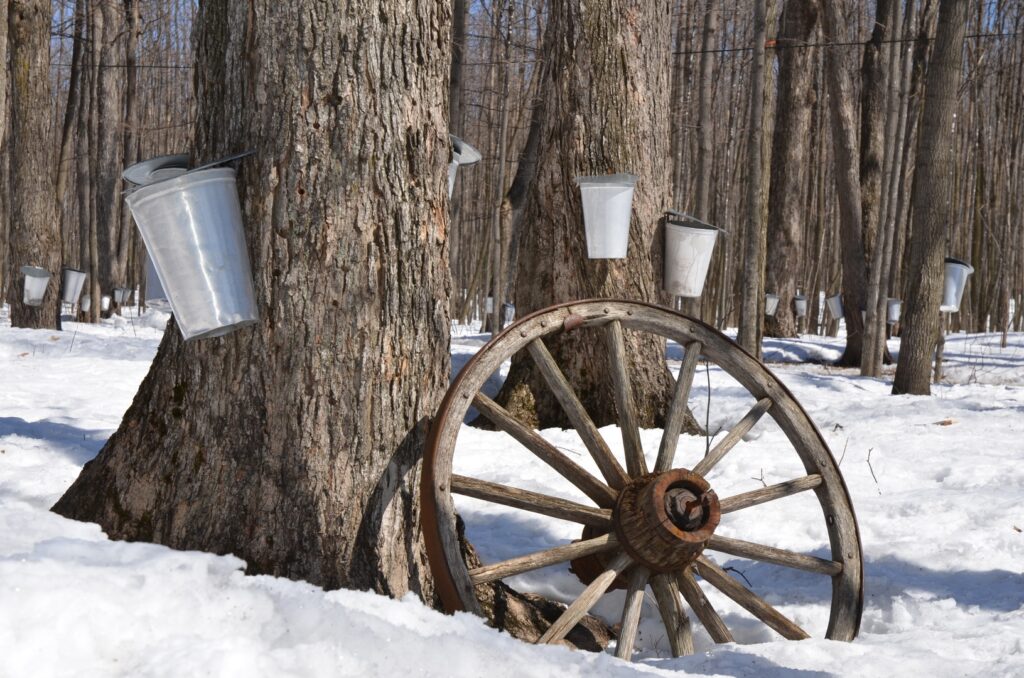
It’s still too cold here in the Pacific Northwest to see much happening outside, so it seems a perfect time to write about something you can’t see anyway. That “something” is the movement of water and dissolved substances through two pathways: the xylem and the phloem. And before you roll your eyes and go watch TikTok videos, keep in mind that learning about these transport systems is critical to understanding how plants work and caring for them appropriately. To prevent brain overload, we’ll focus on how xylem works this month and tackle phloem next month.

Cross section – xylem elements are large, empty circle. Photo courtesy of Wikimedia 
Longitudinal section showing xylem vessels. Photo courtesy of Flickr (Science and Plants for Schools)
Functional xylem is composed of dead, lignified cells connected into a series of tubes that move water one way – from the roots to the leaves. You can think about xylem like a giant straw sucking water out of the soil and moving it into the atmosphere. You’ll find dissolved substances in xylem water, such as soil minerals and root-stored compounds including growth regulators and sugars. Since this is a one-way highway, everything in the xylem ends up at the end of the straw, which is primarily the leaves. Most of the water dissipates into the atmosphere through the stomata (a process called evapotranspiration) and the dissolved substances are left behind.
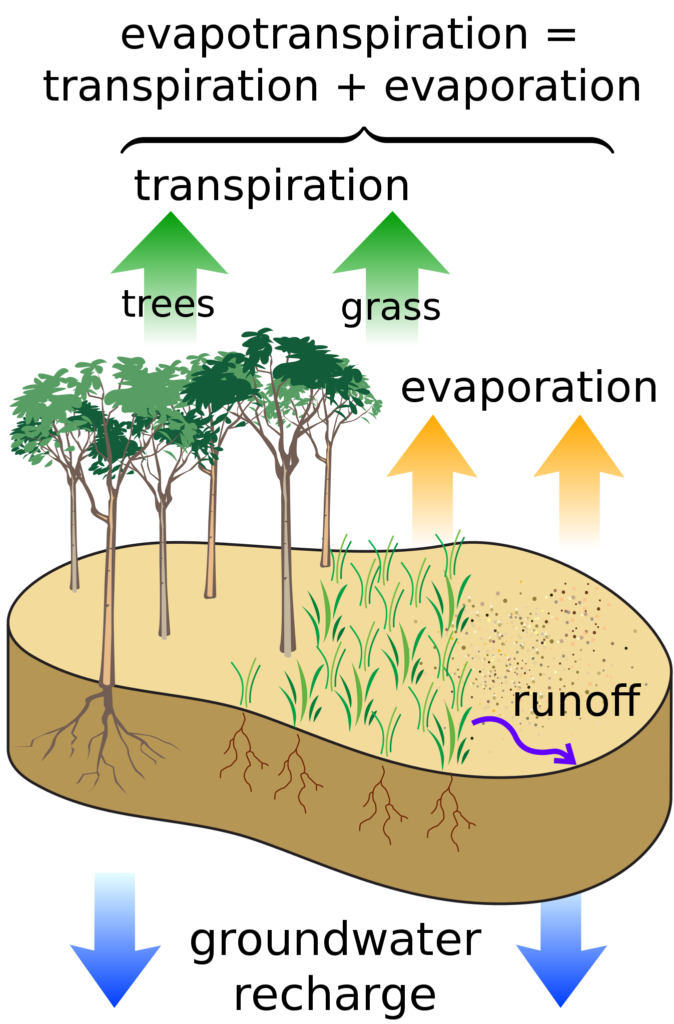
I mentioned that sugars can be found in the xylem, which will confuse gardeners who correctly associate sugars moving through the phloem. That’s generally true except during late winter when some trees, most famously maples, will produce a sugary sap in the xylem. While the exact mechanism of sap production remains unclear, we know that the sugars are coming from storage sites in the trunk and require a freeze-thaw cycle to enter the one-way xylem highway.
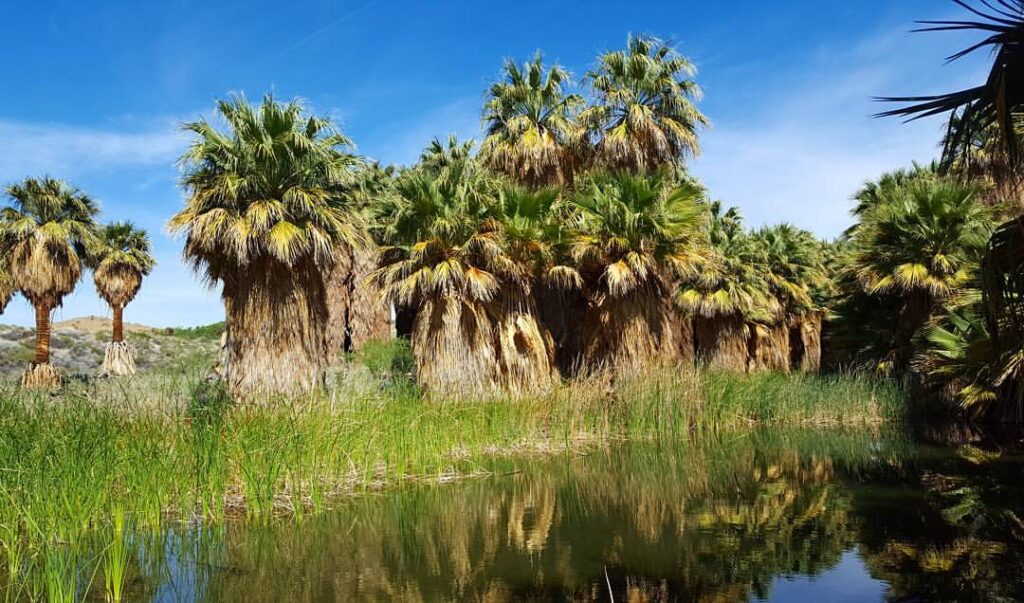
While many people see this process as the plant “wasting” water, it is the only way that soil minerals can reach the leaves. In the summer, evapotranspiration lowers leaf temperature through evaporative cooling. Thus, doing anything to interfere with xylem function (like using antitranspirants) will have a long-term, negative effect on plant health. Likewise, anything in the soil that’s taken up by roots may end up in the leaves – for better or worse.

Schematic view of a Casparian strip. Image courtesy of Wikimedia 
Ring of endodermal cells with Casparian strip (see arrows). Photo courtesy of Flickr (Berkshire Community College)
Gardeners need to think about this last caveat carefully. Plant species are highly variable in their abilities to regulate what goes into the xylem and what is left behind in the root tissue. Regulation is controlled by a barrier called the Casparian strip, which is a ring of living cells that require water (and its contents) to pass through their membranes to enter the xylem. You can think of the Casparian strip as a customs office at a country’s borders: some things are allowed in, and others are forbidden. Depending on how selective this border crossing is, soil contaminants can be left behind in the roots or carried through the plant. This is why it is so very, very, important to have your vegetable garden soils tested for heavy metals and other contaminants, and to take precautions if contaminants are found.
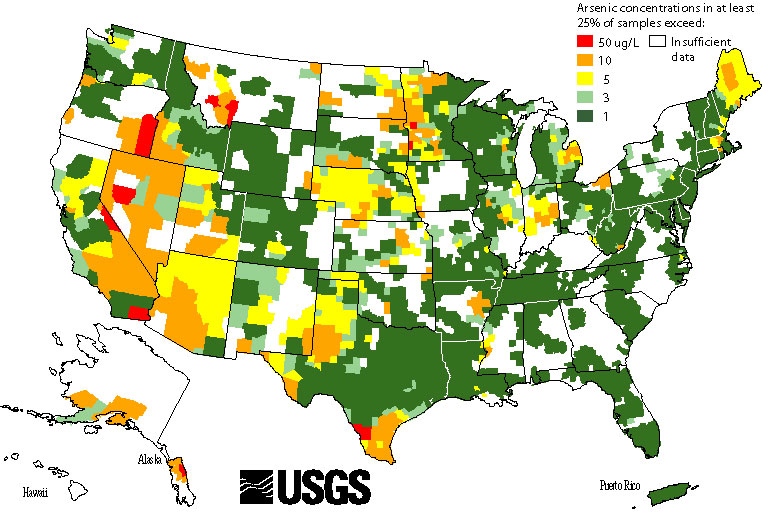
Home Greenhouses III: Basic Structure Types
Over the last few months I’ve had the chance to talk about the popular topic of home greenhouses. We covered a few of the basics in my first article, then touched on some regulations that might effect the building and management of home greenhouses in some areas. In this installment we’ll talk a bit about common structures used for home greenhouse construction so you can consider which structure(s) might be right for your situation.
Types of Structures
Greenhouse structures can range from simple to the very complex. While home greenhouses tend to fall on the simple construction side, there are still varying degrees of complexity within structures. Greenhouse structures can be put into a few main categories that we’ll cover below. The key to home greenhouse success is picking the structure that works best for you, your situation, and your budget.
Lean-to structures
Lean-to structures get their name from the fact that they “lean” on something for support. Not in a literal sense, but in a sense that another structure, usually a house or maybe a storage building, provides at least one structural wall. A common lean-to setup would have a three-sided greenhouse structure attached to the side of a house or another building. This could range from a structure that is a few square feet for starting seedlings in the spring up to a full-size greenhouse attached to the side of a building. A sun-room, if equipped for starting plants, could be considered a lean-to greenhouse (at least it would at my house, since it would be primarily for plants). This type of structure can be cost effective. You reduce the amount of greenhouse surface you have to build and cover, unless you have special issues for connecting it to your home or other structures (like foundation issues, siding that is hard to attach to, etc). You do want to make sure it is done right especially if attached to your house so you reduce the chance of damage to your home.

One benefit to a lean-to is that it can use the wall it is attached to as a heat sink – the wall absorbs heat through the day and then slowly releases it at night when it is colder. If you have a large lean-to greenhouse that serves almost like a sun room you also add functional space to the house where you can enjoy the sun on warm winter days. The heat generated by an attached greenhouse can help provide warmth for your home in winter or at least provide some extra insulation. But it can also result in excessive heat gain in the summer. Lean-to greenhouses are also protected a little more structure wise – they use the building they are attached to for structural support and can often withstand weather, like high wind, a little better than free standing structures.
Free standing structures
Simply put, a free-standing structure is one that isn’t attached to another structure. It stands on its own structural framework. There are a few different options we’ll talk about here which will be further expanded in future article installments on different types of materials used.
Hoophouse greenhouse
A hoophouse greenhouse is built out of the same structure used for a high tunnel or hoophouse. It consists of framing made by bent metal pipes and is covered with polyethylene plastic sheeting. A high tunnel greenhouse would have heating, ventilation, and watering equipment added and would therefore require connection to electric, gas, and water utilities (see my previous article about what this means for a greenhouse being a taxable “permanent” structure). You may also pour a concrete slab for the floor of a hoophouse-to-greenhouse conversion, but gravel or any other floor covering is fine as long as it provides a stable surface and weed control. The “greenhouse” that I inherited from the previous homeowners was left with bare ground so they could plant it like a conservatory.

While these may not be the most attractive greenhouses, they are usually a more cost-effective option for a high-quality, efficient greenhouse. Initial construction costs will likely be lower for a comparable quality framed greenhouse though the polyethylene covering will need to be replaced every few years as it becomes more opaque and light transmission reduces.
Free-standing structures
When envisioning a greenhouse, many people envision this type of greenhouse – one with straight sides, built with a frame covered in solid material. These are definitely more attractive than hoophouse greenhouses and can add an attractive feature to your yard. The most common way for home gardeners to build a free-standing greenhouse is through purchasing a kit. There are a myriad of kits available online these days, of varying prices and qualities usually depending on the materials used in the construction. The kits can be complex but set-up is usually pretty easy to follow though you might want to factor in the cost of hiring a contractor to help with the construction on a bigger kit. Most often these kits need to be built on a concrete foundation or pad so you’ll want to consider the cost and logistics of pouring the needed support. And you’ll also want to think about the utility connections to the greenhouse.

Ridge and furrow greenhouses are framed greenhouses that are built together in tandem. These structures are usually used only in large-scale commercial production, so I’ll skip those for home greenhouses.
Geothermal greenhouses
Geothermal greenhouses are gaining in popularity, mainly because people are excited about reducing the need for using electricity or gas to control the temperature. And I say reducing, because in extremely cold weather there will likely still need to be supplemental heat. These structures are definitely different than your standard greenhouse. These structures are usually sunken into the ground to take advantage of insulation by the soil and also the constant geothermal temperatures. There is also usually a high solid wall on the north side of the structure, with a slanted roof made of light-passing material that faces to the south. This allows maximum light to enter the structure and allows that light to heat the solid wall to hold and release it during the night when it is colder. There is also usually an air intake in the ground a few hundred feet away that allows for the pulling of air through a tubing system to warm or cool the air with geothermal temperatures, depending on if it is cold or hot outside.
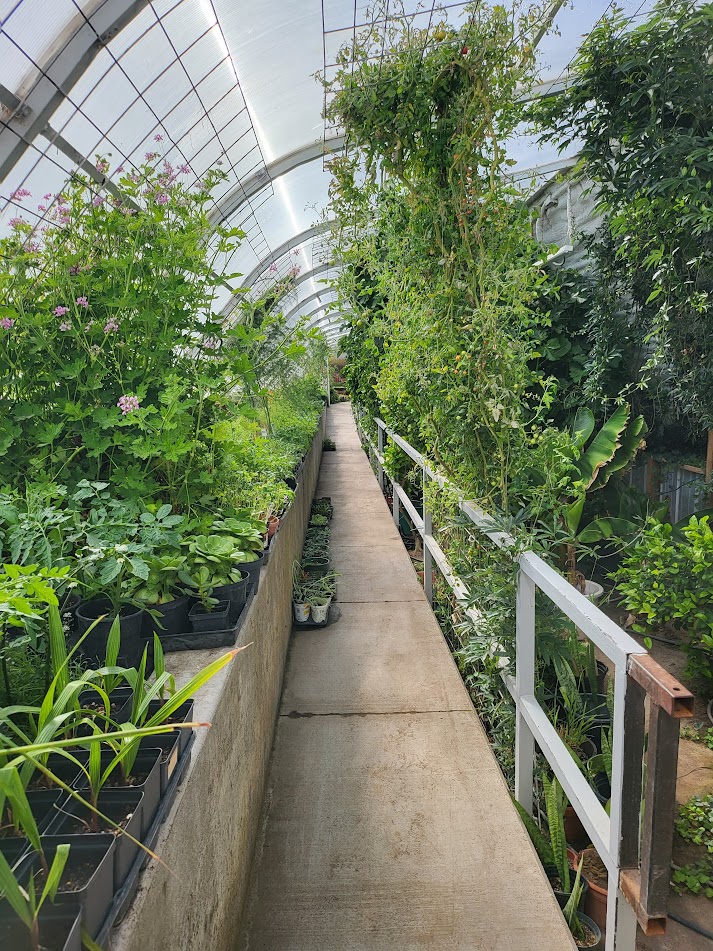
A walpini greenhouse is a specialized/rudimentary style geothermal greenhouse that is sometimes referred to as a pit greenhouse. Instead of building a structure, it is constructed of a pit dug into the ground and covered with a transparent roof. While they sound simple, there are several drawbacks to these structures. One – they don’t do well in wet areas or areas with high water tables, for obvious reasons. Secondly, they were initially designed for use in areas near the equator with the sun almost directly overhead. To function in latitudes far north or south you almost always have to build up a wall on one side to slant the roof cover toward the sun. And even then it is unlikely that light will reach the floor of the structure where plants are growing.
Summary
There’s a lot to consider when picking the type of greenhouse structure for your home greenhouse. There’s often a trade-off between cost, quality, and aesthetics. Options range from the simple to the complex in terms of size, structure, and function. So think about the goals you have for your greenhouse and consider the many different options available to you.
Sources
https://aggie-horticulture.tamu.edu/ornamental/greenhouse-management/greenhouse-structures/
https://extension.uga.edu/publications/detail.html?number=B910&title=hobby-greenhouses
Chill out! Winter cold and chill hours for fruit
If you have fruit trees in your garden, then you may already be aware of the importance of winter cold for the development of blooms and fruit. Some fruit varieties like apples, cherries, peaches, and blueberries all need a certain number of hours of temperatures below 45 F to prepare the trees to bloom in the spring. Surprisingly, other trees you might not think of as fruit trees also need a period of cold conditions to produce a good crop, including pecans and olives. Many other garden plants also require cold periods to provide the best blooms, such as lilac and hydrangea. I miss seeing lilacs here in the Southeast because we just don’t get cold enough to meet their chill requirements, although new varieties that can flourish in warmer conditions are being developed.

Why do some plants need winter cold?
The cold conditions over winter cause the plants to go into dormancy. That helps protect the plants from harsh conditions over the winter. Once the plants experience the number of chill hours required for that plant, they are ready to begin the blooming process once the temperature warms up. If the fruit trees do not get enough hours of cold over the winter, they do not bloom well in the spring and blossoms may be delayed or bloom at irregular times or not bloom at all. Leaf emergence may also be affected. The potential yield of fruit is reduced due to the lack of a strong uniform bloom.
Scientists count the number of hours a tree or orchard is below 45 F and measure the accumulation of those hours as “chill hours.” Some publications call them “chilling hours” instead. They are usually accumulated starting around October 1 and go through the winter into the spring bloom period when bud break occurs. An alternate method for calculation only counts the hours between 45 and 32 F. Chill hours are different from cold hardiness, which is the lowest temperature that a tree or plant can tolerate without dying. Recent research has allowed scientists to develop more sophisticated methods that dynamically calculate “chill portions”—these calculators take into account variations in temperature over time and can reset the calculation if cold conditions return after a warm spell.

Picking the right fruit variety for your garden
Most types of fruit other than citrus and each variety has a preferred minimum number of chill hours for that variety to set a good fruit crop. If you live in the Southeast, you may be able to plant varieties of blueberries that require only a few hundred chill hours, where in the north you may be able to plant a more cold-hardy variety that requires over 1,000 chill hours for the best bloom. Because of the cold outbreak we had this December, some of our blueberry varieties are already blooming this year in the warmer weather we have had in January.
If you are planning to plant a fruit tree in your garden, you will want to pick a variety that matches the expected number of chill hours for your area. If you plant a variety that expects a lot of chill hours but your location gets only half that amount, you will not get very good yields from your trees since the plants won’t break dormancy correctly. But if you pick a variety that requires a low number of chill hours for your area, then the tree will be ready to bloom as soon as the chill hour requirement is met, which could put them at risk for a frost if they bloom too soon. So picking the right variety for your area is crucial! Most nurseries can provide the recommended number of chill hours for the fruit variety you pick.
In the future, as temperatures get warmer under the influence of greenhouse warming, most areas will see a decrease in the average accumulation of chill hours over time. We are seeing this at my weather network stations in Georgia and in many other states as well. If you plant something that has a long lifetime, you may want to plant varieties that require fewer chill hours than your current climatological average to make sure they will thrive in a warmer climate in the future.
Where can you find information about chill hours for your location?
For average numbers of chill hours for the United States, check out the map below. Keep in mind that your local microclimate will affect the number of chill hours your garden will receive.

Here are some sources of current chill hours for this year:
The Georgia Weather Network has a tabulation of stations with current accumulations since October 1 at https://weather.uga.edu/aemn/cgi-bin/AEMN.pl?site=AAAA&report=ci. Many other state agricultural weather networks provide similar information. You can find a list of many of them listed under the Partners tab at the National Mesonet Program website.
The Midwestern Regional Climate Center has a current map for the contiguous U.S. similar to the at https://mrcc.purdue.edu/VIP/indexChillHours.html. An interactive version based on GIS maps is at https://mrcc.purdue.edu/gismaps/vipstndata.htm.
AgroClimate has a chill hour calculator for Florida and Georgia at https://agroclimate.org/tools/Chill-Hours-Calculator/ which allows you to choose the chill hour model and the time period of interest.

Don’t forget to check out our archives!
If you are interested in this topic or have other questions about gardens and gardening, we encourage you to explore our archive of blog posts to see if you can find the answer to your questions. Here are a few of the previous stories about winter chill you might find interesting:
Chill hours and bud break in Christmas trees:
https://gardenprofessors.com/and-now-for-something-completely-different/
https://gardenprofessors.com/the-walking-dead-christmas-tree-edition/
Chill hours and lack of flowering in landscape plants like lilac:
https://gardenprofessors.com/why-doesnt-my-plant-flower-part-1/
Another “drainage solution” that makes problems worse
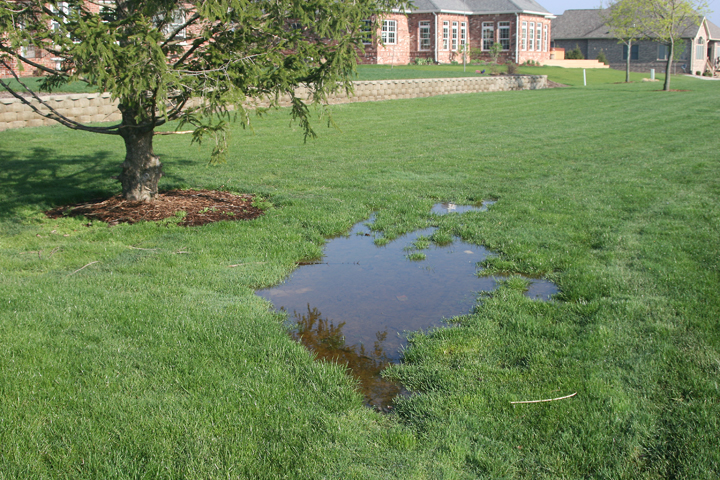
I received an email this week from an arborist colleague who had been sent an “engineering solution” which claims to help with rooting issues in clayey soils or areas where root area is reduced. There was a spiffy diagram accompanying this which I’ve reproduced below.

I could dissect this for you and point out all the problems right now, but instead I’d rather supply you with some factual information and let you apply it to this “engineering solution.”
- Planting hole material that is not the same as the surrounding soil will have reduced water, air, and root movement due to the abrupt changes in texture. The hatched material in the pit appears to be different from the surrounding soil, leading to the assumption we’ve got modified backfill. Here’s a peer-reviewed journal article that discusses the fallacy of soil amendment.
- “Augured sump drain/root channel bores” are simply modified French drains. French drains serve to move free water (i.e., water that is not in soil pores) somewhere. Where “somewhere” is in this case is unclear.
- French drains and other drainage systems do NOT reduce the amount of water that soil holds. Field capacity is the term used to describe a saturated soil. A sandy soil has a low field capacity and drains quickly. The higher the clay content of a soil, the higher the field capacity and the slower the drainage.
- “Drainage material” placed beneath the root zone will slow water movement and create a perched water table above the “drainage material.”
- Drains as well as soils that are full of standing water have no oxygen. Roots will not grow where oxygen is unavailable.

I don’t think I need to belabor these points any further. The bottom line is that you are going to create textural discontinuity problems in the planting pit if you follow these guidelines.
Home Greenhouses Pt. 2: Regulations & Restrictions
Last month I dipped into some of the considerations of owning or building a home greenhouse, having just “inherited” a greenhouse with my new house. The questions and comments were numerous, so I decided to continue on discussing considerations for home greenhouse ownership and operation. There will likely be a few more articles down the line….so strap in.
This time around, I thought I’d talk about something that we hate to talk about, but is important to understand: rules and restrictions around what you can and can’t do, especially if you live in an urban area or municipality.
I know, I know. We all just wish we could do whatever we want, but when we live in close proximity to others there are usually some sort of rules we have to follow to keep the peace. I have a little better understanding of how it works, now that I helped write an urban ag ordinance with our city planning department (fingers crossed is passes city council next month!) that will “decriminalize” urban farming, including controlled environment ag structures like greenhouses. Of course, aside from what you can and can’t do there are tax implications that you should be aware of, no matter where you live (more on that in a bit).
Zoning, Ordinances, and Planning Commissions – oh my!
Most agricultural activity, which includes greenhouses, is likely regulated to some extent if you live within a municipality. Even if you don’t live in a town or city, there could be certain building codes or ordinances on county or state levels that you’ll want to check into.
You’ll want to look up your municipal code online, or call your municipal administration (like city hall, mayor’s office, planning office, etc.-whatever you have) to see if there are specific allowances or restriction for or against greenhouses. There are a few scenarios that could play out here, so you’ll want to be prepared on how to proceed. In general, you might find that greenhouses are:
- Permitted, but only in certain zoning areas (more on that later)
- Permitted, but requiring a permit of some sorts
- Restricted altogether
- Not mentioned at all
If you fall in that last category, then anything you do will exist in a gray area, where it isn’t strictly legal or illegal but the fate of your greenhouse (or any fines you might incur) would be up to interpretation by whoever is in charge of compliance (and what side of the bed they woke up on that day). And your greenhouse could be made legal or illegal at any time in the future if some sort of ordinance or decision is made. In the case of our new ordinance here in Omaha, greenhouses and structures like high tunnels will be allowed, but only in certain zoning areas. People who already have structures (and have for years) will now find that those structures are either allowed or banned (or will require a permit). Of course, enforcement of issues like this are often complaint-based, meaning that the municipality probably isn’t driving around looking for your greenhouse but if you and your neighbor aren’t on good terms they can call and turn you in.
As for zoning, there are several different categories and sub categories. The ones you’re most likely to encounter are residential, commercial, industrial, and agricultural (there are others as well). And then there are usually numeric (or named) sub-zones within those zones denoting the density or intensity of use on those zones.
For example R-1 (Residential 1), might be for a single-family dwelling whereas R-3 would be for a small apartment building. C-1 (Commercial-1) might be for a single-use building like a stand-alone fast-food restaurant and C-8 might be for a skyscraper office headquarters. Municipalities use these codes to denote what is and what is not allowed in certain places. For example, the code we worked on for Omaha allows certain types of farming on all residential zones with a conditional use permit and on commercial zones without a permit. (Home gardens and even community gardens are not considered farms and are allowed on all residential zones without a permit.) Many municipalities may also have agricultural zoning on properties around the periphery but still within the city/town limits. On lots like this, most agricultural practices are allowed.
/cdn.vox-cdn.com/uploads/chorus_image/image/58423213/Screen_Shot_2017_12_14_at_4.58.18_PM.0.png)
Since a greenhouse is a structure, there may or may not be a requirement for a permit for the structure, even if it is allowed. This could be dependent on a number of factors, including whether it is considered a permanent or temporary structure, whether there are utilities going to it (which is usually the case for a greenhouse), or even how the structure is constructed. In some areas, it comes down to how pretty or ugly the city and your neighbors think the structure might be. In discussions for our ordinance, there was talk of not requiring a permit for a greenhouse but requiring permits for structures like high tunnels/hoophouses because there’s an (incorrect) assumption that greenhouses are prettier than high tunnels. But many people make greenhouses out of those structures (the greenhouse I inherited is just a high tunnel with a space heater). There was also an assumption that a greenhouse wouldn’t have loud, flapping plastic but a greenhouse would (I kid you not).
The tax man cometh….for your permanent agricultural structure.
One other thing you’ll want to consider about a greenhouse has to do with the tax bill. Since greenhouses are considered permanent structures, many places consider them a permanent improvement to your property and will add them to the tax bill like they might do an out building or garage. The municipality will definitely know about it if you have to apply for a permit or if you get a visit from the assessor. But this could also be dependent on how your structure is built. If you build a solid sided greenhouse (one of the nice looking ones) with a concrete slab floor, permanent utilities, etc then it will definitely considered permanent. But if your structure is more like a high tunnel/hoophouse like mine (a high tunnel in a trench coat pretending to be a greenhouse) then it could be considered a temporary structure and not taxable.

High tunnels are considered temporary since you could really take them down at a moment’s notice (and some planning department officials think this means that you take them down and put them up each season, despite how much an extension educator tries to convince them otherwise….but I digress). So your mileage may vary depending on your local rules and how your structure is constructed.
So what home greenhouse topic should we cover next? I’m sure there’s plenty of questions out there – be sure to leave them in the comments. Also – would you like to have your greenhouse featured in a future article (this means I don’t have enough home greenhouse pictures)- feel free to send them to me at john dot porter at unl.edu.
Companion plants, they are not what you think!
Companion plants! Great, what a good idea. When you first hear the term and think about the concept it sounds great but there is a lot to not like about it. The term “companion plants” implies that these plants are partners and they “enjoy” each other’s company. The term is an anthropomorphism or overlaying of human qualities on non-human organisms. A more appropriate term may be plant associates or plant associations, a term taken from plant ecology, which has more basis for use.
Plants naturally grow together in groups which are called plant communities. These plants evolved under certain climate, soil, and environmental conditions that allow them to live together in the same place. Coastal sage scrub, oak woodland, and juniper pinyon woodland are some common plant communities where I reside in Ventura County. All of the plants growing in these communities receive winter rainfall and summer drought (Mediterranean climate) to which they are adapted to grow in. Plants growing here either resist drought through specific plant adaptations such as reflective leaf surfaces (white sage), abundant trichomes (sycamore), microphylly (buckwheat), succulent water storage (agaves, yucca and other lily family bulb forming plants), and C-4 metabolism (grasses). Some plants avoid drought by growing in the rainy season, setting seed and then remaining dormant during hot dry weather. Plants can grow in this climate because they have the adaptations to do so.
Plants compete for resources and while doing so may provide a place for other plants to grow. Trees have an advantage over grasses because they can grow above, catching the sun and shade the grasses out. But shade may also provide a place for shade adapted plants to grow. Plants surviving challenges in a specific environment may end up growing together. Woody plants also provide perching birds a place to defecate and spread seeds. This is why unexpected things may grow under other plants. Shade may even be necessary for development of proper form. We have noticed in studying western hackberry (Celtis reticulata) that the tree has no apical control and will not develop into a tree shape when grown in full sun. When grown in shade apical control is present and the plant grows a straight trunk. Birds commonly eat hackberry fruit and likely disseminate it under the canopies of other plants. I don’t think the hackberry minds growing as a blob but its “companion” plants cause it to change form due to changes in light intensity.

Some plants live very closely with others. Mistletoe is a great example. Leafy mistletoe is a hemiparasite deriving its energy from sunlight of its own leaves but utilizing water and photosynthate from its host. Similarly there are free living plants such as Indian paint brush (a member of the Orobanchaceae) that are also hemiparasitic using their roots to extract benefit from neighboring plants. Holoparasites are true parasites deriving all their nourishment from their hosts, e.g., Dodder (Cuscuta spp.). Dwarf mistletoe is also holoparasitic as it largely lacks chlorophyll. These plants are always found on or near their hosts but it is hard to call them true “companions.” The plants clearly associate with each other and in some cases are detrimental as one of the plants stands to gain nothing from the interaction.

One popular example of “companion planting” is The Three Sisters (TTS) polyculture of corn, squash and beans. This agricultural system is said to be synergistic. Corn provides support for beans and shades the squash, and beans provide nitrogen fixed from the air for the other two members of the system. The system was “practiced” by indigenous Americans all across the continent. Soils, rainfall and climate are quite diverse across the United States, and I am sure that TTS agriculture had mixed success. It is an interesting thought that the human diet can be satisfied by these crops and likely the combination was more about ensuring sustained calories and nutrients for those who grew them. In one published study there was no increase in production when comparing TTS to mono-cultures of the component parts, nor was N increased in soil. This makes sense since it’s not available until the plant dies giving up its nitrogen to the next crop which is the basis of legume cover cropping. Continued use of the TTS system is a zero sum game as corn and squash will rapidly use all the nitrogen from the previous year’s legume crop.
Mutualism is the concept that interactions between two organisms benefits both. There are many examples of plants that have a mutual relationship with insects, birds, fungi and bacteria. I found no examples of plants that have mutual relationships with other plants, e.g., “companion plants”, common to the scientific literature. I thought this was unusual so I called a friend who is a plant ecologist and asked her the question. At first she was enthusiastic and pointed to non-plant-plant relationships. As I redirected her to only plant-plant interactions we could not identify anything. My suspicion is I have missed something important or we will discover one day that there are plants evolved to help one another but for now, it evades me.
There is no doubt that one plant can help another but it’s incidental and not a sign of a mutual relationship. Most plants evolved to grow in communities because the growing conditions are suited to all. Knowledgeable gardeners and landscape architects will group plants that grow well together. This is only common sense.
Understanding how plants grow in nature informs gardeners about adaptations and this in turn elevates the practice of horticulture.


References
Martinez, R.T. 2008. An evaluations of the productivity of the native American ‘Three Sisters’ agriculture system in northern Wisconsin. M.S. Thesis. University of Wisconsin-Stevens Point, College of Natural Resources.
Marsh, E. 2023. The Three Sisters of Indigenous American Agriculture. National Agricultural Library (USDA). https://www.nal.usda.gov/collections/stories/three-sisters
Goodbye to 2022 and hello, 2023!
As we close out 2022, I thought I would spend a few minutes reviewing the weather and climate of the past year, both the average conditions and some of the extremes we saw. While this is skewed towards the United States, I did include some events happening in other parts of the world for our non-US readers.

What were the average climate conditions in 2022?
Since the year is not quite over, I can’t provide a final average for temperature or precipitation for the complete 365 days, but there are some websites that allow me to look at all but the last few days. The images below are from the High Plains Regional Climate Center for January 1 through December 28. They show the temperature departure from normal and the percent of normal precipitation for the continental United States. (You can see the global temperature statistics for January through November 2022 at the National Centers for Environmental Information.) In most parts of the U.S., the temperature was warmer than the 1991-2020 normal; the exception was the north central part of the country, where temperatures were colder than normal. This pattern is consistent with the La Niña that we have been experiencing for most of the year, although individual months did vary.

Precipitation was more variable, as the map of precipitation percent of normal below shows. The driest areas in California and the Central Plains are consistent with the extensive droughts that covered those parts of the country throughout the year. The eastern Coastal Plain also shows overall drier than normal conditions for the year as a whole but the timing of wet summer and dry fall caused a lot of problems for the farmers there. The wettest areas were New Mexico and Arizona (due to a vigorous monsoon), the Southern Appalachians and Mississippi, and the Florida Peninsula due to the heavy rain associated with Hurricane Ian.

What extremes did we see in 2022?
The averages show the overall conditions that occurred this year, but don’t begin to capture the extremes in temperature and precipitation that occurred. These extremes get washed out in the averaging process but are far more likely to cause serious impacts than deviations from normal conditions over the whole year. These extremes caused 15 billion-dollar disasters in the U. S. alone as of October 11, and I certainly expect that extreme events since then, including last week’s cold outbreak and snowstorm, will add to that number.
In 2022, we experienced a number of heat waves with record-setting temperatures, including unusual warmth in South America, Europe, Asia, and Australia, where their highest temperature ever recorded (50.7 C or 123.3 F) was tied in January, their peak summer month. The United Kingdom experienced their hottest year ever, including temperatures in excess of 40 C for the first time. Much of Asia was also very hot in 2022. In the United States, the Pacific Northwest saw heat waves in both August and October, with the Southwest experiencing blistering heat in September and the Northeast in August. By comparison, cold outbreaks occurred both in January and early February and in December, with an Arctic outbreak spreading southeast from Alaska down to southern Florida, bringing extensive freezing conditions that caused significant damage to citrus in Florida and Georgia, bursting water pipes, and a lake effect blizzard in Buffalo NY that eclipsed their previous record-setting snow event set just a month earlier.
Precipitation was just as variable, with floods and droughts occurring around the world this year. Some of the more notable flood events include the rainfall in Pakistan in August that put a third of their country underwater, the floods that destroyed the northern entry to Yellowstone Park in June, and the local flash floods that occurred in eastern Kentucky in summer and fall, and the southwest monsoon that began in June with precipitation 200-800% of normal, easing drought in that area. At the very end of the year, as I am writing this, an atmospheric river event on the West Coast is bringing heavy rain to areas of California that have been plagued by drought all year. That may provide some relief from the dry conditions going into 2023.

Many other areas of the world experienced significant droughts in 2022. They include an extreme drought that occurred over most of Europe, causing damage to many crops and limiting navigation on local rivers. This was also true in the United States, where the long-lasting drought in the central United States led to record low levels on the Mississippi River, stopping barge traffic that usually transports grain from the Midwest down to the Gulf of Mexico. Drought covered over half of the United States for many months in 2022, although it waxed and waned in some areas with the movement of rain-producing systems.
How about the tropics?
While La Niña usually means that the Atlantic tropical season is active, this year was oddly quiet between early July and the end of August, with no storms observed during this period for only the third time since 1950. But once the season resumed, we saw Hurricane Fiona (affecting Puerto Rico and Nova Scotia, although it stayed offshore for the continental eastern U. S.) and Hurricane Ian in September. Ian caused tremendous death and destruction to southwestern Florida as it crossed over the peninsula, dropping feet of rain before it moved into the Atlantic Ocean and then recurved west into South Carolina as a weakened storm. In November, Hurricane Nicole brought devastating coastal flooding to areas that were previously affected by Ian, although it caused less damage than Ian did. Damage from tropical systems was not confined to the tropics, however, as the remains of Typhoon Merbok hit the west coast of Alaska in September, causing significant coastal damage with its incredibly strong winds.
What does the past year teach gardeners?
Most of the United States as well as the rest of the world experienced a warmer climate in 2022, so gardeners will continue to need to choose plants that are appropriate for their warming climate zones. But they will also need to prepare for extreme conditions; devastation by individual storms as well as climate variability will continue to affect home gardens through water stress caused by drought and extreme heat as well as damage caused by floods, high winds, and freezing temperatures. Building a resilient garden that can withstand these extremes will allow your garden to thrive through whatever conditions the atmosphere throws at it.
Thank you for another great year!
Finally, I want to end this year by thanking you all again for your loyal readership and your thoughtful questions and comments on many topics. I encourage you to share your 2022 garden challenges (weather or otherwise) in the comments along with your plans for how you plan to address them in 2023 and beyond. I look forward to reading them! We will see you again in the New Year.
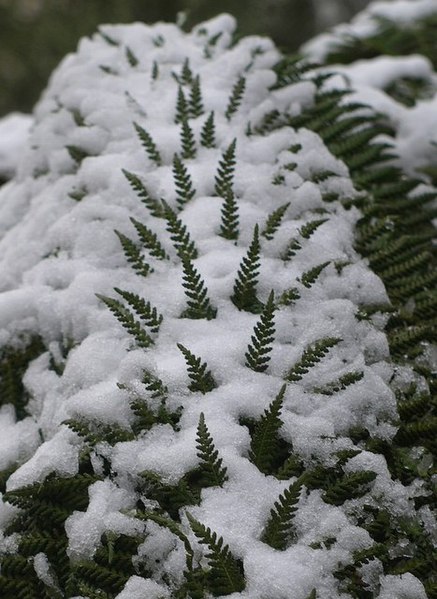
Pest Profile: Spotted Lanternfly
We have seen many high-profile examples of insect invasions, and as gardeners, we have probably come across some of these species in our very own landscapes and experienced their impacts first-hand.
If you live in the Eastern part of the United States, you have probably already heard about one of these invasive insect species that is currently wreaking havoc. The Spotted Lanternfly (SLF), Lycorma delicatula, is a 1 inch long planthopper native to China, and has since spread to Japan, South Korea, and the United States. This is a piercing/sucking insect (Order: Hemiptera) that feeds on the phloem of plants and excretes a sweet and sticky product called honeydew. This feeding damage, especially in large populations, can impact the health of certain plant species. Not to mention the nuisance potential, as any objects under infestations of this insect will find themselves coated in a sticky layer of honeydew.
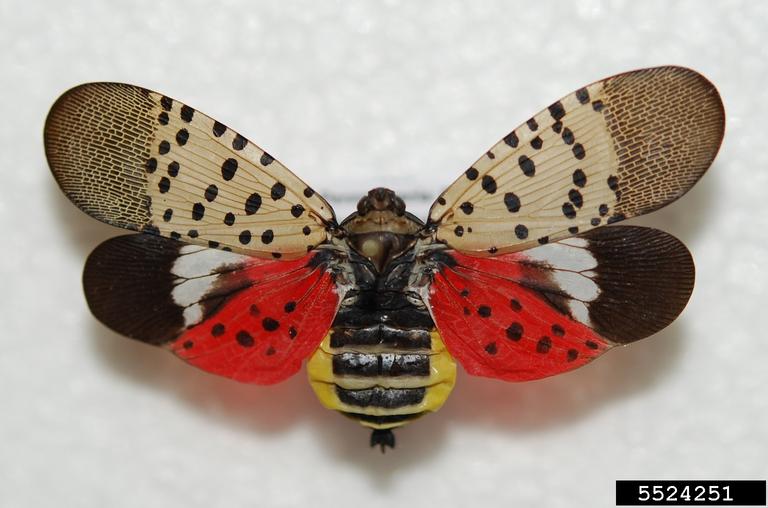
It was first detected in Pennsylvania in 2014, and can now be found in several surrounding states including Delaware, Indiana, Maryland, Massachusetts, Michigan, New Jersey, New York, North Carolina, Ohio, Rhode Island, Virginia, and West Virginia, although most states are considered at risk for SLF invasion. Although the insect itself can’t fly long distances, it can be easily spread by moving infested materials and through their egg masses which look fairly nondescript (like a small smear of mud). Several states are currently quarantining this pest, so follow regulatory guidelines by visiting your state’s department of agriculture. Inspect your vehicles and personal effects for the insects and their egg masses (and scrape them off/squish them) especially if you are traveling through these quarantine areas to prevent spreading them to new locations.
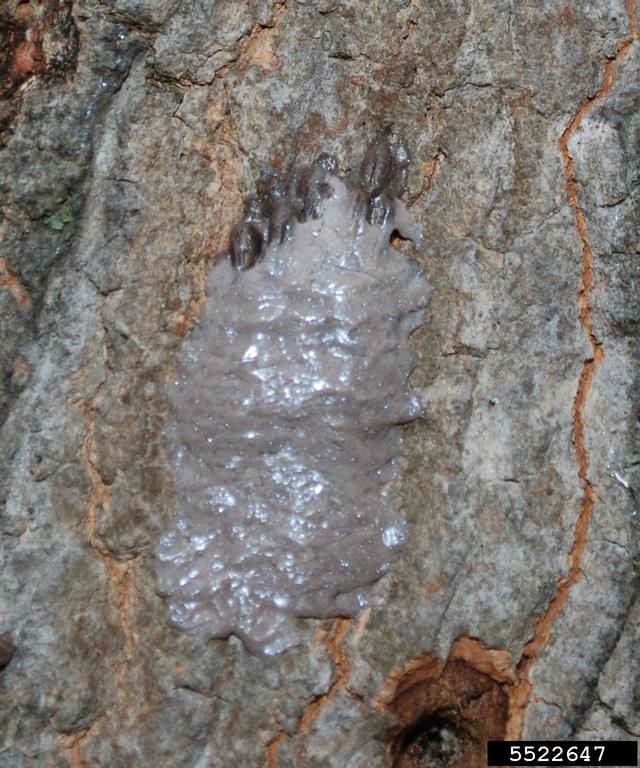
This insect has over 100 potential host species, and this wide dietary breadth adds unique challenges to this insect’s pest potential. Its preferred host plant is another invasive species: Tree of Heaven (Ailantis altissima), which is currently widespread in the US and parts of Canada.
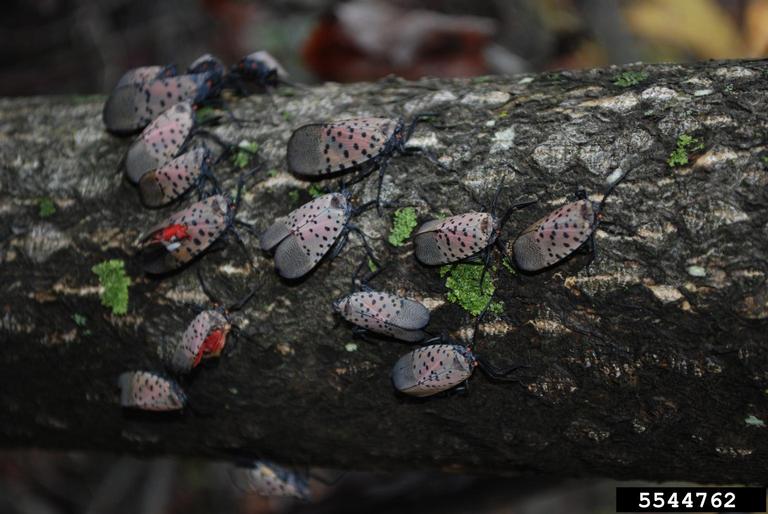
SLF can also be problematic for some important fruit crops such as grapes, where it has the potential to reduce fruit yield, impact fruit quality, and potentially reduce hardiness and winter survival. There are also other economically important trees that this insect feeds on, including apple, maple, black walnut, birch, willow, etc.. Feeding damage can stress plants leaving them susceptible to other pests and diseases. If this pest continues to spread it could have significant impacts on the US grape, horticulture, and forestry industries.
Invasive insect species can also have significant impacts on natural ecosystems, and can tip the balance of a well-functioning food web. Adding a pest that often has very few adapted natural enemies, and especially those that can reduce the availability of an important food and shelter source for other native organisms can result in cascading ecological effects that can be difficult to understand and manage.

It is important to stay vigilant in keeping an eye out for invasive species such as Spotted Lanternfly, so if you see this insect outside of a currently quarantined area, before you squish the bug; take note of where you spotted it and report it!
State-specific reporting guidelines for Spotted Lanternfly can be found here: https://www.aphis.usda.gov/aphis/resources/pests-diseases/hungry-pests/the-threat/spotted-lanternfly/
If you are curious about other current/potential invasive pests in the US (and state specific guidelines for invasive pests) visit: https://www.aphis.usda.gov/aphis/resources/pests-diseases/hungry-pests/pest-tracker
To learn more about this insect, visit: https://ag.umass.edu/landscape/fact-sheets/spotted-lanternfly
You can also reach out for more information to your state department of agriculture, or your local and regional extension offices.
